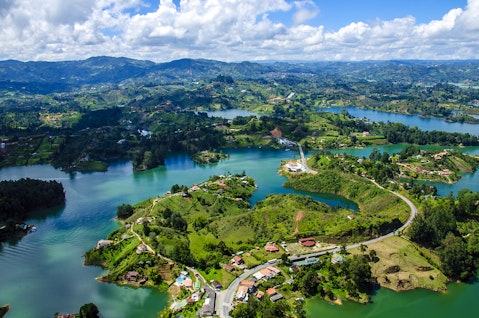This insightful article will list the most geographically diverse countries in the world, along with discussing such diversity’s tourism and economic impact. You can skip the details and read 5 Most Geographically Diverse Countries In The World.
Countries with unique landscapes and cultural attractions have the potential to use tourism as a significant economic driver. However, the appeal of tourism isn’t solely based on the natural beauty of these countries, it is also influenced by accessibility, safety, infrastructure, and effective marketing.
Tourists, upon visiting ecologically rich countries, spend on various services, from accommodation to dining, thereby directly injecting capital into the local economy. Such an influx of revenue often leads to job creation, benefiting the local populace. Moreover, as tourism grows, authorities planning to capitalize on the industry may emphasize enhancing infrastructure, which, in turn, can make the region more attractive to tourists and potential investors.
A salient example is Portugal. After grappling with an economic and debt crisis from 2011 to 2014, the country witnessed a tourism resurgence starting in 2015. Cities such as Porto and Lisbon rapidly emerged as top tourist destinations. As a consequence of this uptick in tourism, approximately one million direct and indirect jobs were established in Portugal between 2015 and 2019. The tourism sector in Portugal currently employs close to 950,000 individuals, accounting for 21.1% of the country’s GDP, roughly a fifth of its total economy.
It’s imperative to acknowledge the role multinational corporations play in the tourism, hospitality, and travel domains, assisting these nations in optimizing their inherent scenic beauty. Renowned companies like Marriott International Inc (NASDAQ:MAR) hold significant trust among international tourists who often favor established brands over lesser-known regional hotel chains. A concrete illustration of this is Marriott International Inc’s deliberate expansion into African countries where it attracts a worldwide clientele, invariably benefiting the hosting territory.
Also read: World Tourism Rankings by Country: Top 20 Countries
According to the Q2 2023 earnings call of Marriott International, there was robust growth in the Average Daily Revenue (ADR) globally. Moreover, the Revenue Per Available Room (RevPAR) in Greater China doubled. Marriott International Inc (NASDAQ:MAR)’s international RevPAR also surged by an impressive 39% year on year. With operations spanning 138 countries, the company’s international occupancy rate reached 68% in Q2 2023, and its ADR experienced a 14% rise.
Nevertheless, not every country with abundant geographical assets can fully capitalize on them. Take Russia, for instance, its vast geographical diversity could significantly bolster its economic prospects through tourism. Yet, recent geopolitical events and an unpleasant business atmosphere, which pushed major corporations to wrap up in Russia, have thrown its tourism sector in turmoil.
After 2022, numerous major industry players like Marriott International Inc (NASDAQ:MAR) and Airbnb Inc (NASDAQ:ABNB) have reduced their footprint in Russia, thereby impeding the country’s ability to draw foreign visitors. Notably, the suspension of Airbnb Inc (NASDAQ:ABNB), a platform known for democratizing travel accommodations and economically benefiting local hosts, has deprived many Russian citizens of a vital revenue source.
It’s worth noting that with an average room rate of approximately $67 per night, Airbnb’s offerings are often more affordable than traditional hotel chains. Such cost-effectiveness makes it a favored choice among travelers. In 2022, the company’s revenue surged to $8.4 billion from $5.99 billion in the previous year. As per their Q2 2023 earnings call, Airbnb Inc (NASDAQ:ABNB) recorded bookings of 115 million nights and experiences, registering a revenue of $2.5 billion, marking an 18% year-over-year growth.
These instances show the profound influence of established mega-corporations in shaping the tourism landscape of countries that are known to be geographically diverse.
Also see Best Destinations in the World for Cultural Tourism.
Let’s now talk about the most geographically diverse countries!

20 Most Geographically Diverse Countries In The World
Our Methodology
To identify the most ecologically rich countries, we studied their topography and terrains in detail. We then highlighted key topographical features in these countries that are both unique and impactful. The definition we employed to select the most geographically diverse countries is as follows:
Geographically diverse countries exhibit a wide range of topographical features and variations within their borders, including mountain ranges, valleys, plains, deserts and forests, among others. We coarse-grained these features to be able to practically count them for each country and so granular geographical features were ignored. We then scored these countries based on these coarse-grained features (assigning a score of 1 for each feature) and ranked them in ascending order of scores.
Based on our research, here are the world’s most geographically varied countries:
20. Venezuela
IM Score: 2
Venezuela, distinguished by various natural places, is special in geography. It houses Angel Falls, the world’s highest waterfall, and the Orinoco River, one of the principal rivers in South America, essential for local flora and fauna. Additional topographical features include the Guiana Highlands, rich with unique animals and plants, and Lake Maracaibo, a sizable lake notable for its oil.
19. Peru
IM Score: 3
Peru’s Andes Mountains are renowned for their beauty and unique communities. The expansive Amazon Rainforest occupies a large part of Peru, providing a home to diverse fauna and flora. Additionally, Machu Picchu delivers historical insights amidst the stunning mountain regions. Lake Titicaca, the world’s highest navigable lake, and the Colca Canyon, one of the world’s deepest spots, showcase Peru’s dramatic landscapes. Peru is among the countries with the most natural resources, and is a prominent global producer of silver, copper, lead, and zinc, contributing 12.7% to its GDP.
18. Indonesia
IM Score: 3
Indonesia, the world’s largest archipelago, encompasses over 17,000 islands, such as Java and Sumatra, positioned between two oceans and extending across the equatorial tropics, hosting varied ecosystems. Furthermore, volcanoes, including notable ones like Mount Krakatoa and Mount Rinjani, scatter across the country, while Lake Toba, a large volcanic lake, mirrors serene skies. The country’s tropical climate means it tops all vegetable oil producing countries, with palm oil making 94% of its cumulative oil yield.
17. Madagascar
IM Score: 4
Madagascar, an island in the Indian Ocean, is celebrated as a “biodiversity hotspot” due to its exclusive species not found elsewhere on Earth. Its diverse landscapes include Isalo National Park, the High Plateau, Canyon des Singes and Canyon des Rats, and Nosy Be island. Despite being one of the most underdeveloped countries in the world, facing high poverty levels, Madagascar presents notable topographical interest.
16. Pakistan
IM Score: 4
Pakistan’s geographical features extend from the towering Karakoram Range, which includes the formidable K2, to the expansive Thar Desert, contrasting starkly with the snowy peaks. The fertile plains of Punjab, irrigated by the significant Indus River, play a crucial role in sustaining the country’s agriculture. Another impactful topographical feature, its 100 km coastline, borders Iran to the West and India to the East. Notably, Pakistan shares a border with China in the northeast, providing a shorter route to the Arabian Sea and onward to Africa and the Middle East, enhancing the region’s trade routes and development when capitalized effectively. But despite having varying topographies, the country’s semi-arid belt is almost entirely cultivated, leaving little for the tourists to explore.
15. Portugal
IM Score: 4
Situated on the Iberian Peninsula, Portugal enjoys a predominantly Mediterranean climate, yet its climatic zones are surprisingly varied due to its elongated form and its coastline along the Atlantic Ocean. To the country’s north sit rugged mountain ranges like the Serra da Estrela, the highest point in mainland Portugal. These mountains are interspersed with valleys carved by rivers such as the Douro. Notably, the region, with higher rainfall and cooler temperatures, contrasts with the rolling plains of the Alentejo in the south, characterized by a hot, dry climate.
14. The Democratic Republic Of Congo
IM Score: 5
The Democratic Republic of Congo (DRC), situated in Central Africa, presents multiple topographical features, ranging from thick jungles to active volcanoes. It houses the Congo River, among the world’s deepest, essential for transportation and fishing. Similarly, the vast Congo Rainforest, home to unique wildlife such as gorillas, is vital for global biodiversity. Meanwhile, the Rwenzori Mountains and the active Nyiragongo Volcano form stunning backdrops. Despite challenges like poverty and disease, the country’s features mold the lives of locals and provide habitats for numerous species.
13. Mexico
IM Score: 5
Mexico’s Sierra Madre mountains, essential for climate and biodiversity, provide habitats for various species and resources for inhabitants. The Sonoran Desert, recognized for its flora, and the Yucatán Peninsula, noted for its stunning beaches and valuable Mayan ruins, exemplify the country’s diverse landscapes. Additionally, the active Popocatépetl volcano and deep Sumidero Canyon illustrate the dramatic natural contrasts across the country.
12. Italy
IM Score: 5
Italy, extending into the Mediterranean, offers a rich geographical landscape that includes Alpine peaks in the north and sun-kissed coasts in the south. The Apennine Mountains shape the country’s “boot” and influence regional climates. The country’s iconic volcanoes, such as Vesuvius and Etna, have shaped both history and land, while the serene Lake Como and the rolling hills of Tuscany showcase Italy’s beauty.
11. South Africa
IM Score: 6
South Africa features the Kalahari Desert in the north and the lush Garden Route along the southern coast. Table Mountain, which overlooks Cape Town, is renowned worldwide for its biodiversity and iconic flat top. The Drakensberg Mountains display majestic peaks vital for local ecosystems and human activities. Furthermore, the Kruger National Park, a world-famous safari destination, sustains a vibrant ecosystem.
10. Turkey
IM Score: 6
Turkey, where the East meets the West, displays remarkable geographical diversity. The striking fairy chimneys of Cappadocia and the white terraces of Pamukkale are major tourist attractions. The Bosporus Strait, a crucial passage for global maritime routes, defines the boundary between two continents. Additionally, the rolling landscapes of Anatolia, the rugged Taurus Mountains, and the Aegean coastlines constitute more notable topographical features of the country.
9. India
IM Score: 7
The Himalayas, home to the world’s highest peaks, contrast sharply with India’s flat and fertile Gangetic Plains. The Thar Desert, shared with Pakistan, offers expansive sandy terrain, while the Western and Eastern Ghats exhibit rich biodiversity. Major rivers like the Ganges flow through India, hosting various ecosystems that significantly impact agriculture and the livelihoods of its substantial population. The country also has an extensive coastline, ensuring continuous access to the Arabian Sea and further towards the Middle East and Africa.
8. Argentina
IM Score: 8
Argentina’s Andes Mountains in the west significantly influence the country’s climate and ecology. The Pampas, extensive grasslands, are crucial for the country’s agriculture and cattle raising. Moving south, Patagonia offers windswept plains and stunning glaciers, which provide habitats for varied wildlife. The country’s geography, featuring Iguazu Falls in the north and the icy shores of Tierra del Fuego in the south, supports diverse ecosystems and is essential to its identity.
7. New Zealand
IM Score: 10
Though small, New Zealand possesses an impressive array of geographical features. The Southern Alps on the South Island are celebrated for their stunning peaks, while the North Island showcases geothermal wonders like Rotorua. Fiordland National Park, with its breathtaking, glacier-carved fiords and the sunny beaches of the Coromandel Peninsula, highlight the country’s environmental diversity.
6. Australia
IM Score: 11
Australia, a continent on its own, hosts the highest number of deserts in the world, marked by arid conditions, hot temperatures, and sandy landscapes. The Great Barrier Reef, the world’s largest coral reef system, is situated to the country’s northeast and significantly influences its ocean biodiversity. Furthermore, mountain ranges like the Grampians and the Snowy Mountains provide varied climates and habitats. The arid, red expanses of the Outback starkly contrast with the lush environments of the Daintree Rainforest, affirming Australia’s status as one of the most diverse countries.
Click to continue reading 5 Most Geographically Diverse Countries In The World.
Suggested Articles:
- 25 Most Famous Bridges in the US
- Top 20 Most Beautiful Island Countries in the World
- 35 Most Beautiful Places In The World
Disclosure: None. 20 Most Geographically Diverse Countries In The World was originally published at Insider Monkey.





